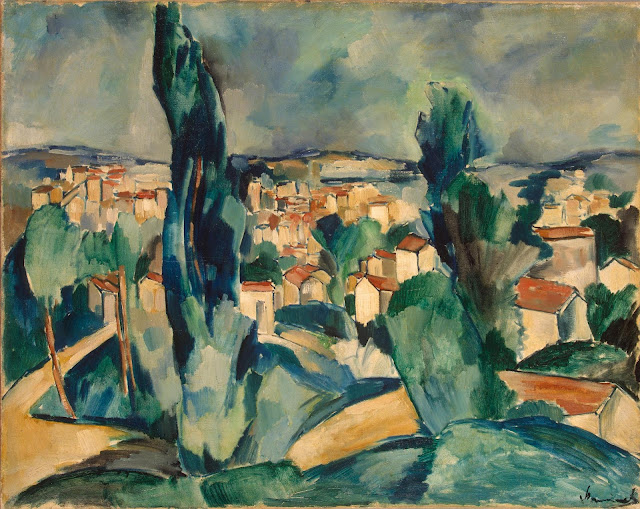 |
| Henri Matisse Luxembourg Gardens ca. 1901 oil on canvas Hermitage, Saint Petersburg |
 |
| Paul Gauguin Sunflowers 1901 oil on canvas Hermitage, Saint Petersburg |
"Unlike white, yellow is the less synthetic colour, possessing a strong optic pulsation and tending toward real space, to an unmooring of itself from the material structure and to expanding itself. It tends toward the sign, in a more profound sense, and to the optical signal (or indicator) in a superficial sense. It must be noted that the meaning of the indicator is of no interest to us here, for coloured structures function organically within a fusion of elements, constituting an organism that is separate from the physical world, from the surrounding space-world. So its meaning would indicate a return to the real world and, therefore, a trivial experience, consisting merely in the signage and virtualization of real space. Here, the meaning of the signal is one of direction; it is internal to the structure and in relation to its elements, the sign being its profound, non-optical, temporal expression. Unlike white, yellow also resembles a more physical light, closer to terrestrial light. What is important here is the time-light sense of colour; otherwise it would still be another representation of light."
 |
| August Renoir Landscape - Le Cannet 1902 oil on canvas Hermitage, Saint Petersburg |
 |
| Charles Guérin Young woman reading ca. 1906 oil on canvas Hermitage, Saint Petersburg |
 |
| Maurice Denis Cupid carrying Psyche to heaven 1908 oil on canvas Hermitage, Saint Petersburg |
 |
| Henri Matisse Nympyh and Satyr 1908 canvas Hermitage, Saint Petersburg |
 |
| Henri Matisse Dance 1908-09 oil on canvas Hermitage, Saint Petersburg |
"Luminous red differs from darker blood red and possesses special characteristics within this experience. It is neither light red nor vibrant sanguine red, but a more purified luminous red that does not quite become orange because of dark colours, but as a pigment it is open to light and warmth. It possesses a cavernous, grave sense, such as might be produced by a dense light."
 |
| Henri Rousseau In a tropical forest - struggle between tiger and bull ca. 1908-09 oil on canvas Hermitage, Saint Petersburg |
 |
| Maurice de Vlaminck Town ca. 1908-09 oil on canvas Hermitage, Saint Petersburg |
 |
| Maurice de Vlaminck Town on lake shore ca. 1909 oil on canvas Hermitage, Saint Petersburg |
"The other derived and primary colours – blue, green, violet, purple and gray – may become more intense as they approach light, but they are colours of an opaque nature, closed to light, except for gray, which is characterized by its neutrality in relation to light. I shall not deal with these colours now, for they possess more complex relationships that have not yet been explored here. All we have seen thus far is the relationship of colour to colour, of the same quality, in the sense of light. The colour-light of various qualities has not also been explored here, for such an investigation will depend upon a gradual development of colour and structure."
 |
| Maurice Denis Psyche's family bids farewell on the mountaintop 1909 oil on canvas Hermitage, Saint Petersburg |
 |
| Jean Puy Portrait of the artist's wife 1909 oil on canvas Hermitage, Saint Petersburg |
 |
| Henri Rousseau View of fortifications 1909 oil on canvas Hermitage, Saint Petersburg |
 |
| Maurice Utrillo Rue Custine, Montmartre 1909-10 oil on cardboard Hermitage, Saint Petersburg |
"In representational painting, the meaning of space was contemplative, and that of time mechanical. Space was what was represented upon the canvas, fictitious space, and the canvas functioned as a window, a field for the representation of real space. Time, then, was simply mechanical: the time from one figure to another or from that figure's relationship to perspectival space; finally, it was the time of figures in a three-dimensional space which became two-dimensional on the canvas."
– quoted passage are from Body of Colour by Hélio Oiticica, first published in Brazil in 1960, translated by Stephen A. Berg and issued in English by Tate Publishing in 2007